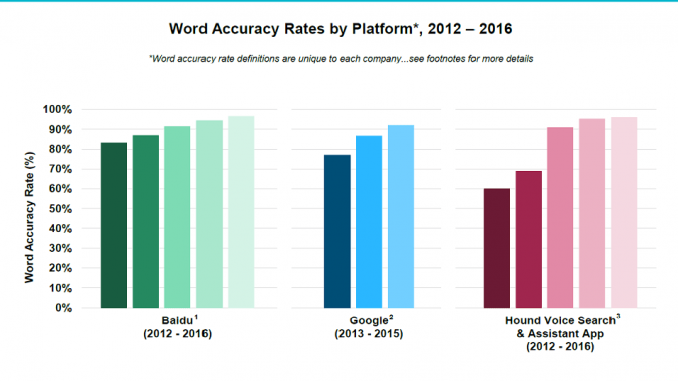
The ubiquity of virtual assistants like Siri, Cortana and Alexa, together with improvements in technology, have led to an uptick in voice search queries.
For businesses that rely on local search traffic, this has important ramifications for their strategy.
So how can businesses ensure they aren’t left behind when it comes to local search?
Produced in collaboration with Brandify.
OK, Google…what’s going on with voice search?
Voice search is a growing trend that has been pinging the radars of savvy search marketers for the last few years.
In 2016, conversational AI company MindMeld surveyed smartphone users in the US, finding that 60% of users who used voice search had started using it in the last past year – indicating rising adoption rates. This is backed up by Mary Meeker’s 2016 Internet Trends Report, which found that Google voice search queries in 2016 are up 35x over 2008, now making up 20% of searches made with the Google Android app.
It’s not hard to see why. Voice searches are fast (humans can speak at 150 words per minute, versus typing at 40 wpm), convenient (instant, hands-free) and increasingly reliable.
Rising word accuracy rates are a big factor. Usage in the US grew from 30-65% between 2013-2015, with 35% citing improvements in technology as the primary reason for adopting it.
In its early stages, voice recognition had an accuracy of below 80%, rendering the service buggy and difficult to use. Today, Google’s word accuracy rate is over 90%.
But the real driver of widespread adoption has been the omnipresence of virtual assistants like Siri, Cortana, Google Assistant – all of whom will automatically perform a web search if they are unable to answer a question natively.
SEO company HigherVisibility surveyed 2,000 mobile phone users and found that 27% of respondents use voice search assistants daily, while another 27% use them at least once a week.
What does this mean for search traffic?
More searches using natural language
Whereas regular searches usually just include keywords (‘IHOP opening times’), voice searches tend to be structured using full, grammatically correct sentences (‘what time does IHOP open on a Sunday?’).
In fact, Google is currently working to better accommodate these so-called ‘natural language’ queries. At the Google I/O developer conference last year, Google CEO Sundar Pichai revealed Google Assistant’s ability to handle follow-up questions without the need to re-state the context.
This allows you to search something like “Who directed The Revenant?” followed immediately by “Show me his awards”.
More searches on mobile
The convenience afforded by voice search comes into its own when users are on mobile. Although available on desktop web for Google and via Siri for Mac (as of OSX Sierra), voice searches don’t make as much sense in a desktop environment.
Higher Visibility found that over half (53%) of those that used voice search used it when driving, and another 21% used it when doing another activity.
More searches with local intent
According to Meeker’s Internet Trends Report 2016, mobile voice-related searches are 3X more likely to be local-based than text-based queries. This makes local SEO critical for businesses seeking to appear in these results.
What does it mean for your marketing strategy?
Look to target long-tail and natural language keywords in content
For the question-answering content on your site, consider how someone might phrase their search query as a full sentence. If you’re stuck for inspiration, your website analytics should reveal at least one or two search terms that tick this box.
Creating an FAQs page is an easy way to optimize for this, as it both asks and answers the most relevant queries for customers – and puts full questions in prominent header tags.
Optimize your site for mobile
In October 2016, global mobile / tablet web browsing finally exceeded desktop, with the former accounting for 51.3%, and the latter 48.7% according to StatCounter.
Mobile-friendliness has been a ranking signal since 2015, but it’s particularly important for businesses who receive traffic from local search from mobile users – such as searches appended with ‘near me’.
Improve your local SEO to target searches with local intent
Google’s Venice update in 2012 improved the triggering of Local Universal results (aka the ‘three-pack’, shown below). This box pops up when faced with queries that have relevant local results, like my Neanderthal request for “food near me”:
Basic SEO advice aside, here are a few simple steps to improve your ranking in these results:
Verify your Google My Business listing including a long, unique and correctly-formatted description that includes links to your business. You should also upload high-resolution photos, opening times, a phone number and a business address that matches your website.
Use a consistent name, address and phone number (NAP) across your online profiles. That includes your Google My Business listing and your website. This information needs to be exact.
Acquire and maintain positive reviews as these have been shown to affect your ranking in local search results. For more on how to manage your reputation online, check out our handy guide: ‘How to handle negative reviews and manage your brand’s reputation‘.
This article was produced in collaboration with Brandify. Click here to read ClickZ’s collaborative content guidelines.
Source: ClickZ
Link: What does voice search mean for your local SEO strategy?



Leave a Reply